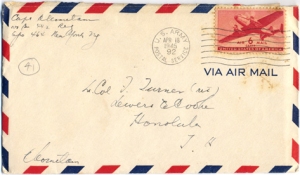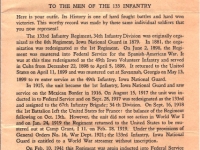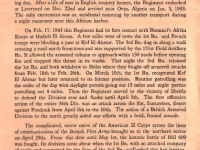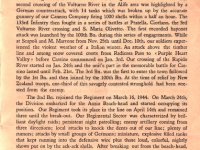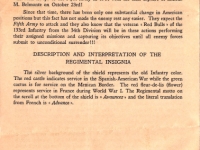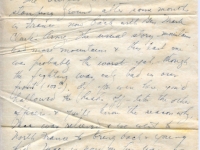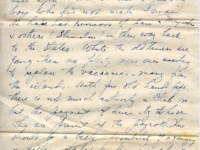133 INFANTRY REGIMENT
TO THE MEN OF THE 133 INFANTRY
Here is your outfit. Its History is one of hard fought battles and hard won victories. This worthy record was made by those same individual soldiers that you now represent!
The 133rd Infantry Regiment, 34th Infantry Division was originally organized as the 8th Regiment, Iowa National Guard in 1879. In 1881, the organization was redesignated as the 1st Regiment. On June 2, 1898, the Regiment was mustered into Federal Service for the Spanish-American War. It was at this time redesignated as the 49th Iowa Volunteer Infantry and served in Cuba from December 22, 1898 to April 5, 1899. It returned to the United States on April 11, 1899 and was mustered out at Savannah, Georgia on May 13, 1899 to re enter service as the 49th Infantry, Iowa National Guard.
In 1915, the unit became the 1st Infantry, Iowa National Guard and saw service on the Mexican Border in 1916. On August 15, 1917 the unit was inducted in to Federal Service and on Sept. 28,1917 was redesignated as the 133rd and assigned to the 67th Infantry Brigade; 34 th Division. On Sept. 16, 1918 the 1st Battalion left the United States for France: the balance of the Regiment following on Oct. 13th. However, the unit did not see action in World War I and on Jan. 24, 1919 the Regiment returned to the United States to be mustered out at Camp Grant, I 11. on Feb. 18, 1919. Under the provisions of General Orders No. 16, War Dept. 1921; the 133rd Infantry, Iowa National Guard is entitled to a World War streamer without inscription.
On Feb. 10, 1941 this Regiment was again inducted into Federal Service as a part of the 34th Infantry Division. Shortly thereafter the Regiment moved to Camp Claiborne, Louisiana where it underwent basic training and took part in the Louisiana manuevers of August-September, 1941. On Jan. 1, 1942 the 133rd moved to Fort Dix, N. J. to prepare for embarkation. On Jan. 15, 1942, Headquarters with Regtl. Hdqrs. Co., 1st Bn., Anti-Tank Co., plus Service Co. sailed from New York for overseas duty. These troops were the first American soldiers to set foot on European soil in World War II as they arrived in Belfast, North Ireland. The remainder of the Regiment left the States on Feb. 19,1942 and arrived in the British Isles on March 2nd. The Irish towns of Londonderry, Armagh, Moy and Caledon with their narrow streets, perpetual dampness and riendly inhabitants are familiar to the «originals» On Sept. 17, 1942, the 2nd Bn. was attached to Allied Force Headquarters, remaining there on guard and police duty throughout the Tunisian and part of the Italian Cam-paigns. On Dec. 10, 1942, the remainder of the Regiment departed from Caledon, N. I. and journeying through Scotland arrived in England the following day. After a life of ease in English country homes, the Regiment embarked at Liverpool on Dec. 22nd and arrived near Oran, Algeria on Jan. 3, 1943. The only excitement was an accidental ramming by another transport during a night maneuver near this African harbor.
On Feb. 17, 1943 this Regiment had its first contact with Rommel’s Afrika Korps at Hadjeb El Aioun. A few miles west of town the 1st Bn. and French troops were blocking a pass at Kef El Ahmar. The 3rd Bn. dug in along a wadi crossing a road north from town and was supported by the 151st Field Artillery Bn. It allowed the armored column to approach wihin 150 yards before opening fire and stopped this thrust in its tracks. That night the 3rd Bn. rejoined the 1st Bn. and both withdrew to Sbiba where they fought off armored attacks from Feb. 18th to Feb. 26th. On March 10th, the 1st Bn. recaptured Kef El Ahmar but later returned to its former position. Routine patrolling was the order of the day with daylight patrols going out 15 miles and night parties patrolling out 4 miles. Then the Regiment moved to the vicinity of Sbeitla to defend the Division rear and flanks until April 5th. The first offensive action of the entire 34th Div. was an attack across the flat, featureless, desert against Fondouk from April 8th to the l0th. The action of a British Armored Division to the north greatly aided our efforts with a bold, frontal assault.
The complicated, secret move of the American II Corps across the lines of communication of the British First Army brought us to the northern sector on April 29th. From this date until May 1st, the historic battle of Hill 609 was fought. Its decision came about when the 1st Bn. with an attached company of tanks and supported by the fires of the 3rd Bn. outflanked this key bastion. From May 4th until the 8th, the outfit participated in the battles for Eddek-hila and Chougui Pass over mountainous terrain similar to that in Italy. Through the greater part of the Tunisian Campaign this Regiment and the 34th Division were part of the American II Corps under command of Generals Patton and Bradley.
A period of rest, relaxation, reorganisation, training and preparation took place during the remainder of our stay in Tunisia and Algeria. Just before leaving North Africa for Italy, the 100th Infantry Battalion composed of Hawaiian born American citizens of Japanese extraction was attached to take the place of the 2nd Bn. attached to AFHQ in Algiers.
The 133rd Infantry was the only combat loaded element of the 34th Div. on the voyage to Italy and it started to land on the beaches at Salerno on Sept. 22nd. From Sept. 27th until Oct. 5th, the 133 Infantry Combat Team operating between the Fifth and Eighth Armies pursued Kesselring’s Army from Salerno through Benevento and forced a crossing of the Calore River. The second crossing of the Volturno River in the Alife area was highlighted by a German counterattack, with 14 tanks which was broken up by the accurate gunnery of our Cannon Company firing 1000 shells within a half an hour. The 133rd Infantry then fought in a series of battles at Pratella, Ciorlano, the 3rd Volturno River crossing and S. Maria Olivetto. The first recorded bayonet attack was launched by the 100th Bn. during this series of engagements. While at Scapoli and M. Marrone from Nov. 25th until Dec. 10th, our soldiers experienced the violent weather of a Italian winter. An attack above the timber line and among snow covered crests from Radicosa Pass to « Purple Heart Valley » before Cassino commenced on Jan. 3rd. Our crossing of the Rapido River started on Jan. 24th and the unit’s part in the memorable battle for Cassino lasted until Feb. 21st. The 3rd Bn. was the first to enter the town followed by the 1st Bn. and then joined by the 100th Bn. At the time of relief by New Zealand troops, one-third of this savagely contested stronghold had been wrested from the enemy.
The 2nd Bn. rejoined the Regiment on March 16, 1944. On March 24th, the Division embarked for the Anzio Beach-head and started occupying its position. Our Regiment took its place in the line on April 14th and remained three until the break-out. Our Regimental Sector was characterized by brilliant daylight raids; persistent night patrolling; enemy artillery coming from three directions; local attacks to knock the dents out of our line; plenty of rumors; attacks by small groups of Germans; miniature, explosive filled tanks that kept running into the defensive wire plus those loud, colorful, nightly shows put on by the ack-ack shells. After breaking out from the beach-head, the Regiment fougnt a furious engagement at Lanuvio; attacked through Genzano di Roma, Albano Laziale and the tired, equipment laden unit entered Rome on June 6th after a blistering 15 mile march along a rocky railroad bed and over hot, dusty roads. Then a rapid advance was made through Civitavecchia and through an ambush at Tarquinia, a battalion of enemy bicycle troops was completely annihalated. The period from June 26th to July 2nd was characterized by brief but bitter battles at Castiglia, S.Vincenzo and Cecina. From July 8th until July 31st, the outfit fought from Castellina to the Arno River and during these actions its sector was eight miles east of Leghorn and four miles east of Pisa. Re-entering the fight on Sept* 7th, the Germans lodged in the Appenine mountains and Gothic Line were driven back from Legri to Montepiano* On Oct. 1st, we started to battle for ths critical terrain feature known as M. Venere. By Oct. 11th, the Regiment was well beyond Mon-znno at the northern end of this hill. It can be pointed with pride that this Regiment, the 133rd Infantry, made the last successful attack on the part of American troops of the Fifth Army in 1944 with the final capture of famous M. Belmonte on October 23rd!
Since that time, there has been only one substantial change in American positions but this fact has not made the enemy rest any easier. They expect the Fifth Army to attack and they also know that the veteran « Red Bulls » of the 133rd Infantry from the 34th Division will be in these actions performing their assigned missions and capturing its objectives until all enemy forces submit to unconditional surrender!!!
DESCRIPTION AND INTERPRETATION OF THE
REGIMENTAL INSIGNIA
The silver background of the shield represents the old Infantry color. The red castle indicates service in the Spanish-American War while the green cactus is for service on the Mexican Border. The red fleur-de-lis (flower) represents service in France during World War I. The Regimental motto on the scroll at the bottom of the shield is « Avauncez )> and the literal translation from French is « Advance »_
Edited by Regimental Information & Education Offices Published by Special Services Off,; Passed by Base Censor, MTOUSA
April 16
Dear Col.
Just received this pamphlet through the (J?)& E of 133 Inf – it’s history & record. You may be interested to know that they have not forgotten the addition of the 100th as their 2nd Bn.
The outfit is back to its old stomping ground after some months in France – now back with Gen Mark Clark’s Army. The usual story – mountains and more mountains & this last one was probably the worst yet, — though the fighting was only bad in our front (100th). If you were here, you’d hallowed the heads off – like the other officers – & you’ll know the reason why. Mac was relieved & we went to North France to bring back [illegible] young kids. Mac is now on his way, from what I understand. We have Major Jack Conley (Maui) & he did a swell job. Mits as Exec and Koga as S. and a new S4. The rotation has taken Grandstaff, [illegible], Fronin, Kawano, and McGill which leaves Corbin, Koga, Chaplain and I the only ones. We are just bidding time – andhope it’ll be Hawaii [time?] in a month or so. Some how – the rotation business is a headache to the men as everyone has his own opinion. Fitzhugh – (Texas moustache) returned to unit after TD – so did a few other boys who did not make Hawaii. We have had reunions of Sam &Miyashiro and others (Shimatsu) on their way back to the States. While the old timers are going, there are plenty new ones awaiting to replace the vacancies – many from the islands. With few old hands left, there is not much activity on Club 100 – but the payment of dues by those who are present at the payroll. There should be a better possibility of organizing and getting started in Hawaii – especially with so many returning. Have been requested often to broaden the club and open it to all 100 Bn men& also make concessions to the 442 from Hawaii. But, as the bloody mess is not over, there may be time to discuss it. Aloha to Mrs. Turner and hope you are in good health.
Kome

